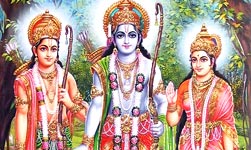.
Ram Navami-2010
The birth of a hero
Ram Navami is a festival that celebrates the birth of Lord Rama, the son of King Dasharath. It was a joyous occasion in Ayodhya all those centuries ago when King Dasharath's heir was finally born. It was like a dream come true for the king as the lack of an heir had troubled him sorely for many years.
Lord Rama is an avatar of Lord Vishnu who came down to earth to battle the invincible Ravana in human form. Lord Brahma had been receiving complaints from all the gods about the havoc that Ravana was wreaking on earth, but because Lord Brahma had granted Ravana so many boons, he could not be killed by a god. But Ravana had become so overconfident that he would never expect an attack from a human being. So Lord Vishnu agreed to go to earth in the guise of Prince Ram, the son of King Dasharath and Queen Kaushalya.
The story of Lord Rama as told in the great epic Ramayana is one that most Indians know irrespective of caste, creed and religion. Lord Rama is a legendary figure, the epitome of all that is good and true, the man who vanquished the demon king Ravana. Lord Rama is not just a hero, but has been given the status of a god by the Hindus. Therefore, it comes as no surprise that his birth is celebrated year after year with great pomp and enjoyment on the ninth day after the new moon in Sukul Paksh (the waxing moon), which falls sometime in the month of April.
The festivities
So how is Ram Navami celebrated? Some people choose to fast on this day. The diet of such a person would include potatoes made in any form without haldi (turmeric), garlic, ginger or onion. He can also eat fruit and root vegetables of any kind. Curd, tea, coffee, milk, and water are also permitted.
Bhajans praising the exploits of Lord Rama, his loyal brother Lakshman and his devoted wife Sita are sung. The house is swept clean and pictures of Lord Rama, Lakshman, Sita and Hanuman are put on a dais in preparation for the puja. Flowers and incense are kept before the deities. There are two thaalis kept ready in the puja area. One contains the prasad and the other the items necessary for the puja like roli, aipun, rice, water, flowers, a bell and a conch.
First, the youngest female member of the family applies teeka to all the male members of the family. A red bindi is applied on the foreheads of all the female members. Everyone participates in the puja by first sprinkling the water, roli, and aipun on the gods and then showering handfuls of rice on the deities. Then everybody stands up to perform the arti at the end of which ganga jal or plain water is sprinkled over the gathering. The singing of bhajans goes on for the entire puja. Finally, the prasad is distributed among all the people who have gathered for worship
Assinar:
Postar comentários (Atom)


















































Happy Ram Navami 2018. Check out the best Result for your search.
ResponderExcluirRam Navami wallpapers
Ram Navami GIF Images
Ram Navami Animated Pictures